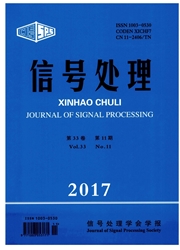

 中文摘要:
中文摘要:
在两对用户通过一个公共中继节点的协作进行数据交换的无线通信环境下,该文研究了基于机会式网络编码的中继策略,即中继节点可以转发编码的分组,也可以转发未编码的分组的中继策略,说明了该中继策略与传统的复制重传中继策略相比能极大的减少系统功率消耗。传统的中继策略几乎必然导致分组的递交时延,而在机会式网络编码的中继策略下,中继节点为提高能量使用效率也可能导致某些分组递交时延增加。通过建立一个马氏链,该文刻画了在机会式网络编码的中继策略下每个分组的平均时延和平均功率消耗。仿真结果说明平均时延和平均功率消耗之间存在着某种折衷关系。对于缓冲区大小为1的情形,该文给出了这种折衷关系。
 英文摘要:
英文摘要:
This paper investigates the strategy of relaying based on opportunistic network coding over wireless communication context with two pairs of users and one common relay exchanging their data,where the relay node can transmit either network-coded or uncoded packets,and presents that this strategy of relaying can substantially decrease the system power consumption against the traditional strategy of copy and forward.Although the traditional strategy can almost surely induce the delay for packets,the strategy of relaying based on opportunistic network coding can also bring in the same result if the relay node pursues just only the energy efficiency.Resorting to a Markov model,the paper characterizes the average delay and power consumption for each packet when using the relaying strategy based on opportunistic network coding.The results of simulation indicate that there exists some tradeoff between delay and power consumption. For the case of buffer size M = 1,the tradeoff is presented.
 同期刊论文项目
同期刊论文项目
 同项目期刊论文
同项目期刊论文
 PA-SHWMP: A Privacy-Aware Secure Hybrid Wireless Mesh Protocol for IEEE 802.11s Wireless Mesh Networ
PA-SHWMP: A Privacy-Aware Secure Hybrid Wireless Mesh Protocol for IEEE 802.11s Wireless Mesh Networ Combined energy detection and one-order cyclostationary feature detection techniques in cognitive ra
Combined energy detection and one-order cyclostationary feature detection techniques in cognitive ra A Cooperative Sensing Based Cognitive Relay Transmission Scheme Without a Dedicated Sensing Relay Ch
A Cooperative Sensing Based Cognitive Relay Transmission Scheme Without a Dedicated Sensing Relay Ch Performance analysis and threshold selection for cooperative multiple packet reception based on NDMA
Performance analysis and threshold selection for cooperative multiple packet reception based on NDMA Detection time analysis for the multiple-user cooperative spectrum sensing scheme in cognitive radio
Detection time analysis for the multiple-user cooperative spectrum sensing scheme in cognitive radio Cooperative Relay Techniques for Cognitive Radio Systems: Spectrum Sensing and Secondary User Transm
Cooperative Relay Techniques for Cognitive Radio Systems: Spectrum Sensing and Secondary User Transm 期刊信息
期刊信息
